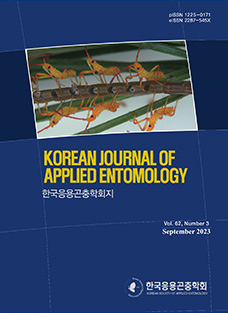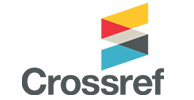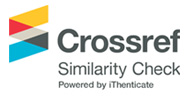Meganola major (Hampson) is one of metropolitan species of Nolidae which was described by Hampson (1891) in India, Nilgiris as Nola major. It belongs to the genus Meganola Dyar now, after László et al. (2015). However in the Korean literatures, its taxonomic status did not follow as it. So we clearly organize Korean history in Part I, to clarify somewhat ambiguous content.
Only the hostplant genus Terminalia (Combretaceae) was known until 2011, but Sasaki and Kishida (2011) reported Lagerstroemia indica, and Juglans mandshurica (Fagaceae) was reported by Heo (2021).
Recently, this species has occurred simultaneously throughout Jeollanam-do, causing significant damage. They fed whole leaves and buds of L. indica and made only branches (Fig 1). Situations of these regional outbreak, the need for research on the species has emerged. There has been little known about their biology; therefore, we provide brief overview of their biology in Part II.
Materials and Methods
The larvae samples were mainly collected from South costal sites Haenam, Wando, and Gangjin in September 2022. During the daytime, we tried to find damaged host plant of L. indica on the road side trees and surveyed them with the naked eye. Some larvae from Gangjin were collected and reared in the Insect Breeding Dish (SPL, Pochen, Korea).
All voucher specimens have been deposited in the insect collection of the Jeonbuk National University, Jeonju, Korea (JBNU), Incheon National University, Incheon, Korea (INU) and the Korean National Arboretum, Pocheon, Korea (KNAE), Republic of Korea.
Images of adults were taken by a Tucsen Dhyana 400DC digital camera (Fuzhou, China) attached to a Leica S6D stereomicroscope with dome illuminator Leica LED5000 HDI (Wetzlar, Germany). Genitalia were dissected and examined under a Leica EZ4 stereomicroscope. Genitalia photograph were taken using a Tucsen Dhyana 400DC digital camera mounted on a Leica S8AP0 stereomicroscope with Mosaic software (version 2.3, Tucsen).
Results
Part I. Taxonomical history
Meganola major (Hampson, 1891) was first described as Nola major from Nilgiris, India with female syntype. Its genetic position has been changed repeatedly. The original genus was Nola Leach, [1815], which was subsequently changed to Celama Walker, 1865, Manoba Walker, 1863, and MeganolaDyar, 1898. Although there were some synonyms and subspecies, this study author doesn’t treat subspecies independently.
Historically in Korea, Meganola major was first reported in the Ph.D. thesis by Oh (1991) as a new species: Meganola fulvusanaOh, 1991 with Korean name [Bam-saek-hok-nabang]. The holotype was examined from Yangyang (Gangweon- do Prov.) with two males and two females paratypes from Yangyang (Gangweon-do Prov.), Mt. Weolaksan (Chungcheongbuk- do Prov.), and Suweon (Gyeonggi-do Prov.). Subsequently, several papers and books were published, but the presence of this species was dealt with confusion. In the early checklist after Oh (1991), ESK and KSAE (1994) did not include this thesis list, nor did Choi (2006). However, Kononenko and Han (2007) referred to the thesis and listed almost all Nolinae species therein. Among them, some new species were not listed, but M. major (Hampson) was listed based on M. fulvusana Oh.
Three years later, Paek et al. (2010) published an insect checklist but didn’t refer to Oh (1991) and Kononenko and Han (2007), so only half of the Nolinae species were listed and M. major (Hampson) wasn’t listed. following Paek et al. (2010), Choi (2011) confirmed only six Roeselia spp., excluding M. major (Hampson). In this situation, a noticeable study by László et al. (2015) accepted Oh (1991), thus validationg all Meganola species were validated as species or subspecies. In their study, M. fulvusana Oh is treated as subspecies of M. major (Hampson). The following year, Kim et al. (2016) revised Korean Noctuoidea, including part of Oh’s thesis species. In that paper, Manoba major (Hampson) listed again with the Korean name [Maep-si-hok-na-bang] without any remark. Following Kim et al. (2016), Cha et al. (2019) reviewed Meganola without Manoba major (Hampson), and National Institute of Biological Resources (2019) and Heo (2021) also treated it as Manoba. Recently however, Park and Lee (2021) transferred it from Manoba to Meganola again. Thus, Meganola major (Hampson) is currently the valid name for the species. This history is briefly indicated in Table 1, and taxonomic status is described hereunder.
Following these bibliographies, it is suggested that Meganola major (Hampson) was recorded after Kononenko and Han (2007), even though they didn’t provide adult illustrations and label data but only Korean specimens' genitalia slides.
Part II. Recent outbreak and ecological characteristics
Recently, this species was outbreak in the Jeollanam-do Prov. (hereafter: JN) target on the Lagerstroemia indica. Before that, only Terminalia (Combretaceae) was reported as the hostplant by Holloway (2003), while L. indica was first reported in Japan by Sasaki and Kishida (2011) and Juglans mandshurica was reported in Korea by Heo (2021). Therefore, hostplant range of M. major is identified in two orders (Myrtales, Fagales) and three families (Juglanceae, Combretaceae, Lythraceae).
Following KoFPI (Pine Wilt Disease Monitoring Center in Korea Forestry Promotion Institute, Daejeon), the first notification of the outbreak of L. indica was in Palgeum-do Is. of Shinan-gun in August, 2022 in JN. After that, Taean-gun, Chungcheongnam-do Prov. in August, 2023 was noticed in the mainland of Korea. Subsequently, their colonies were observed in Naju-si, Yeonggwang-gun, Muan-gun, and Hwasun-gun in JN (Jeollanamdo Forest Resources Research Institute). At the same time, authors noticed their outbreak and also found in Wando-gun, Haenam-gun, Gangjin-gun, and Gangjin-gun in JN, and found observation data from Suncheon-si, Gwangyang- si, and Gwangju-si. It was also observed in Buan-gun and Namwon-si in Jeollabuk-do, and Gongju-si and Cheonan-si in Chungcheongnam-do. Shortly, M. major outbreak in Jeollanam- do and Chungcheongnam-do Prov. except Jeollabuk-do Prov. However, Buan-gun also identified this species, so it should be distributed and could be outbreakable.
Because they have not been serious pest, the situation of their outbreak is unprecedented in the world, there’s no detailed ecology or biology of the M. major. Nevertheless, the affected areas have continued to expand from coastal region to inland areas increasing importance of their ecological characteristics.
The authors could observe some larvae biological characteristics that they fed on young leaves and also buds when they grow. The young larvae mainly fed underside of young leaves, but not buds. When they over 3rd instar, can feed buds and whole leaves without midrib. It causes leaves fallen, and remain only tree consequently.
Taxonomic accounts
Genus MeganolaDyar, 1898
MeganolaDyar, 1898: 43. Type species: Meganola conspicuaDyar, 1898 by original designation by monotypy. Type locality: [USA]: Arizona: Fort Grant. Lectotype: female, in coll. USNM. (lectotype designated by Hacker et al. (2012)).
PoliothripaHampson, 1902: 311. Type species: Poliothripa niphostenaHampson, 1902.
Metanolavan Son, 1933: 203. Type species: Metanola myriostigmavan Son, 1933.
Paranolavan Son, 1933: 222. Type species: Paranola bipartitavan Son, 1933.
Antennolade Freina and Witt, 1984: 267. Type species: Nola impura Mann, 1862.
Meganola major (Hampson, 1891) 맵시혹나방
Nola majorHampson, 1891: 48. Type locality: Nilgiris. Syntype: female, in coll. NHMUK.
Nola phaeaHampson, 1900: 35. Type locality: China: Ichang.
Nola formosanaWileman & West, 1929: 190 (preoccupied). Type locality: Formosa [Taiwan]. (a junior secondary homonym of Roeselia formosanaWileman & West, 1928). The objective replacement name is Meganola major takasagoInoue, 1982.)
Celama subpallidaTurner, 1944: 18. Type locality: Australia: Darwin.
Meganola major caesiopennisInoue, 1982: 666. Type locality: Japan: Amami-Oshima Is.: Nishninakama.
Meganola major takasagoInoue, 1982: 666. (the objective replacement name of N. formosanaWileman & West, 1929)
Meganola fulvusanaOh, 1991: 66. Type locality: Korea: Yangyang. [unpublished]
Meganola major maheraLászló, Ronkay & Ronkay, 2014: 39. Type locality: [Indonesia]: Molluccas, Halmahera.
Manoba major (Hampson): Inoue, 1982: 666; Kononenko and Han, 2007: 69; Kim et al., 2016: 141; Heo, 2021: 352.
Meganola major major (Hampson): László, Ronkay & Ronkay, 2015: 260.
Meganola major fulvusana Oh: László, Ronkay & Ronkay, 2015: 260.
Diagnosis. This species is similar to Manoba melancholica (Wileman and West, 1928), but can be distinguished by the more noticeable medio-costal patch, linear postmedial line in adult (Cha et al., 2024). In genitalia, M. major exhibits diagnostic characters that differ from those of sibling species of Meganola spp. (Cha et al., 2019).
Redescription. Habitus (Fig. 2A–B) – Length of forewing 7–10 mm in male, 10–11 mm in female, wingspan 16–24 mm. Antenna bipectinate in male, filiform in female. Head and thorax gray. Ground color of forewing gray to brownish gray; a dark brown hemisphere fascia on medio-costal margin; indistinct medial fascia in some specimens; unapparent postmedial line strongly curved, dotted; subterminal line wavy; cilia dark gray. Ground color of hindwing pale gray, with a discal dot. Abdomen brownish gray. Male genitalia (Fig. 2C–E) – Uncus well-sclerotized beak-shaped, with a pair of thumb-shaped subscaphial process. Tegumen moderate. Transtilla weakly sclerotized. Valva arched; costal margin weakly sclerotized; harpe somewhat finger-like. Sacculus sclerotized, stout. Juxta stout V-shaped. Vinculum V-shaped. Aedeagus moderate, coecum bulbous, with a large robust cornutus. Eighth tergite with two processes anteriorly, and a reversed V-shaped weakly sclerotized posteriorly; 8th sternite sclerotized anteriorly. Female genitalia (Fig. 2F) – Apophyses posteriores longer than apophyses anteriores. Ostium bursae sclerotized, funnel-shaped. Ductus bursae sclerotized, strongly curved at anterior half. Corpus bursae membranous, ovate, with two thorn-shaped signa. Appendix bursae absent.
Material examined. (4♂, 5♀) INU ♀, Mt. Weolaksan, 20 June 1984, Ahn SB, genitalia slide No. SH-357; ♂, Moonsan- ri, Yeongweol, 7 June 1996, Lee HK, genitalia slide No. INU-9109; ♂, Kangwon National University, 4 June 2001, Han HL; ♀, Mt. Jirisan, 14 July 1976, Ha YY; ♀, Forest road, Hwaheung-ri, Wando-gun, 34°20'17.51''N 126°41'46.53''E, 21 July 2021, Bayarsaikhan U, Lee TG, Cha YB. KNAE ♀, Gwang-Reung, 5 August 1993, Weon GJ, sample No. KNAE201509, INU-9194; ♂, Gwang-reung, 28 August 1992, Weon GJ, sample No. KNAE201519, genitalia slide No. INU-9193; ♀, Mt. Jirisan, 15 July 1976, Ha YY, genitalia slide No. CIS Noc. 310; ♂, Mt. Baekwunsan, Gwangyang-si, 25 June 1991, Ahn SB, genitalia slide No. CIS Noc. 305.
Distributions. Korea, China, Japan, India, Nepal, Taiwan, Philippines, Thailand, Sri Lanka, Malay peninsula, Malaysia, Indonesia (Java, Mollucas, Seram, Sulawesi), Borneo, Singapore, Australia, Vanuatu, New Caledonia (László et al., 2014, 2015;Joshi et al., 2021).
Host plants. Terminalia spp. (Combretaceae), Juglans mandshurica (Fagaceae), Lagerstroemia indica (Lythraceae) (Holloway, 2003;Heo, 2021).
Biology. Still, its life cycle is unknown, but we provide photos of its immature stage (larva and cocoon), adult and hostplant to discuss brief biology (Fig 3). The known host plant Terminalia is distributed throughout the Oriental region, but it does not occur in Korea (Holloway, 2003). Among Meganola species, only M. gigas (Butler, 1884) has been reported to damage Juglans (Cha et al., 2019), whereas M. major is the only species known to damage Lagerstroemia indica within the Korean Meganola fauna (Cha et al., 2019;Heo, 2021). The author only found larvae on L. indica, and around damaged trees for moving. Larvae mainly damaged the leaves' downside and the unbloomed buds (Fig 3A, 3E). One noticeable thing is they seem to prefer leaves over buds, even though they appear to favor buds (Fig 3E). If only buds were provided, they showed no preference and eventually died.
In the final larvae stage, their blackish verrucae color changed from orange to reddish-brown. Afterward, they make yellowish-green to dark ocherous cocoons with self-made silk and sometimes other materials (leaves, feces). The pupation period was observed to be almost ten days under indoor conditions. While observing in the field, the final and younger larvae moved to the ground. In the mid of September, Haenam-gun and Jangheung-gun in Jellanam-do Province, most of them moved to the bottom of the stem but rarely on the grass (Fig 3F). It can be presumed they overwinter in larval form or cocoon, not as adults.
Remarks. This species was recorded by Kononenko and Han (2007), based on a Doctoral Thesis by Oh (1991). Unfortunately, M. fulvusanaOh, 1991 [unpublished] adult specimens were lost, and only genitalia slides were housed in KNAE. László et al. (2015) newly listed up Meganola fulvusana Oh [unpublished] also based on Doctoral Thesis. However, these records were published based on an unpublished paper, so it is nomen nudum (ICZN, 2012). It is discussed below.
Discussion
This study provides new insights into the taxonomy of Meganola major, building upon previous records including Oh (1991). However, it should be noted that the first record of Oh (1991) was not officially published as it was a Ph.D. thesis (ICZN, 2012). According to ICZN Article 8, published work complies Article 8, and it is not excluded Article 9. So, Ph.D. thesis constitutes published work by Article 8. However, Article 9, especially 9. 12. example: “A Ph.D. thesis that was distributed only to members of the student's thesis committee is listed for sale in the catalogue of a print-on-demand publisher. The print-on-demand work is a reproduction of the thesis. Because the thesis was an unpublished work in its original form, it remains unpublished. If an editorial process was evident in converting the work to print-on-demand form (e.g., change to single spacing, repagination, addition of running headers), it might be considered published.” This example has been discussed by several authors leading to the conclusion that a thesis is not considered a published paper (Pyron et al., 2016;Song et al., 2019;Yang and Chan, 2019).
In addition, Article 11. 1. required “the name or nomenclatural act must have been published, in the meaning of Article 8. after 1757.” Also Article 13. 1. Mentioned “every new name published after 1930 must satisfy the provisions of Article 11.” Thus, these Articles’ request follows Article 9. 12. through Article 8.
Consequently, we clarify the relationship between M. fulvusanaOh, 1991 [unpublished] and M. major (Hampson, 1891), and also Korean history of this species.












 KSAE
KSAE





